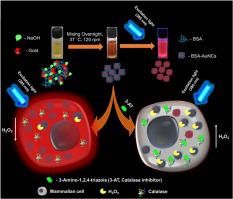Sensors and Actuators B: Chemical ( IF 8.4 ) Pub Date : 2020-09-12 , DOI: 10.1016/j.snb.2020.128886 Vidhi Jain , Stuti Bhagat , Sanjay Singh

|
Gold nanoclusters are well studied due to their facile synthesis, biocompatibility, limited photobleaching, and bright fluorescence properties. Monitoring the reactive oxygen species (ROS) level in mammalian cells is required to assess the healthy metabolism of oxygen, cell signaling, and homeostasis. ROS are also known to cause several human diseases including cancer, neurodegenerative disease, diabetes, and cardiovascular disorders, therefore, following the ROS status could provide important information about the critical pathophysiology of the diseased cells/tissues. Among different ROS, hydrogen peroxide is a well-reported stable oxidative stress biomarker for several diseases. In this work, we report the synthesis of BSA coated AuNCs (BSA-AuNCs) displaying bright red fluorescence (Ex./Em. 511/651 nm), which utilized for the degradation of hydrogen peroxide with concomitant loss of fluorescence of BSA-AuNCs. The fluorescence property of this nanoprobe was used for the detection of hydrogen peroxide levels in liver cells (WRL-68). The accumulation of hydrogen peroxide in WRL-68 cells was artificially induced by 3-amino-1,2,4-triazole (catalase inhibitor) treatment, which leads to a decrease in the fluorescence intensity of BSA-AuNCs to enable fluorescence-based sensing of hydrogen peroxide. Thus, the synthesized fluorescent BSA-AuNCs could be used for the detection of intracellular hydrogen peroxide.
中文翻译:

牛血清白蛋白修饰的金纳米簇:用于检测细胞内过氧化氢的基于荧光的纳米探针
金纳米团簇因其合成简便,生物相容性,光漂白作用有限和荧光性质明亮而得到了很好的研究。需要监测哺乳动物细胞中的活性氧(ROS)水平,以评估氧的健康代谢,细胞信号传导和体内平衡。还已知ROS会引起多种人类疾病,包括癌症,神经退行性疾病,糖尿病和心血管疾病,因此,随着ROS状态的发展,可以提供有关患病细胞/组织关键病理生理的重要信息。在不同的ROS中,过氧化氢是一种针对多种疾病广泛报道的稳定氧化应激生物标记。在这项工作中,我们报告了显示亮红色荧光(Ex./Em。511/651 nm)的BSA涂层AuNCs(BSA-AuNCs)的合成,它用于降解过氧化氢,同时伴随着BSA-AuNCs的荧光损失。该纳米探针的荧光特性用于检测肝细胞中的过氧化氢水平(WRL-68)。3-氨基-1,2,4-三唑(过氧化氢酶抑制剂)处理可人工诱导WRL-68细胞中过氧化氢的积累,从而导致BSA-AuNCs的荧光强度降低,从而实现基于荧光的传感过氧化氢。因此,合成的荧光BSA-AuNCs可用于细胞内过氧化氢的检测。3-氨基-1,2,4-三唑(过氧化氢酶抑制剂)处理可人工诱导WRL-68细胞中过氧化氢的积累,从而导致BSA-AuNCs的荧光强度降低,从而实现基于荧光的传感过氧化氢。因此,合成的荧光BSA-AuNCs可用于细胞内过氧化氢的检测。3-氨基-1,2,4-三唑(过氧化氢酶抑制剂)处理可人工诱导WRL-68细胞中过氧化氢的积累,从而导致BSA-AuNCs的荧光强度降低,从而实现基于荧光的传感过氧化氢。因此,合成的荧光BSA-AuNCs可用于细胞内过氧化氢的检测。



























 京公网安备 11010802027423号
京公网安备 11010802027423号